About the time you enter into Oaxaca state from Tepoztlán, the horizon opens up and you can see miles of mountains on all sides. Dispersed throughout are organ pipe cactus.
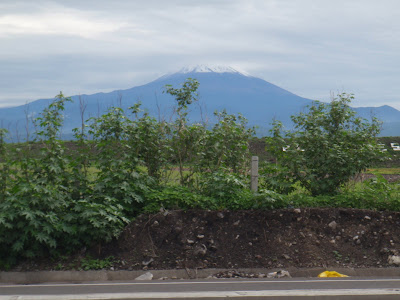
(volcano)



Passing through some random town we even happened upon a motocross competition. It was a little surreal to see such a huge crowd gathered around the track in the middle of nowhere.

We were able to enjoy the ride all morning but in the afternoon, a couple hours outside Oaxaca city, our goal for the day, the big open sky turned ominously dark. We stopped as soon as we felt sprinkles. By the time we were both off the bike we were in the middle of a flash flood, on top of a mountain with no shelter in sight and completely soaked. About the time we had gotten the rain gear on ourselves and the bags on the bike, it started hailing. We had no choice but to keep riding and fortunately the hail only lasted a few minutes. Since rainy season had started while we were in Tepoz, this was the first of what seems to be a very stormy and powerful season. For the rest of the ride into Oaxaca we had rain on and off but nothing like the huge initial downpour, although we did see evidence of some substantial recent rain. We had to ride through some streams of water on the highway that were a good 6 inches deep. Even at fairly low speeds, and particularly with cars passing the other direction, the water splashed up high enough to enter the bottom of our saddlebag raincovers, and the top of Mike´s left boot. This made for some mildew, mank, funk stink hotel rooms for the next couple days. (Even worse than just our usual riding gear)


We got to downtown Oaxaca and stayed in a hostel in the middle of downtown. We spread out our wet gear and found a taco stand. We quickly learned that Oaxacan cheese is delicious. It has a very mild flavor and pulls apart like string cheese. We also had our first tlayuda, another Oaxacan specialty, which is a jumbo sized tortilla folded in half with beans, our favorite new cheese, and any kind of meat you want on the inside. About midway through our meal, the sky opened up again and we had a wet run back to the hostel, trying to avoid rain when possible by selecting blocks that seemed to have the best awnings.
We explored the city the next day, going first to the contemporary art museum and then walking around aimlessly, managing to explore most of the greater downtown area.
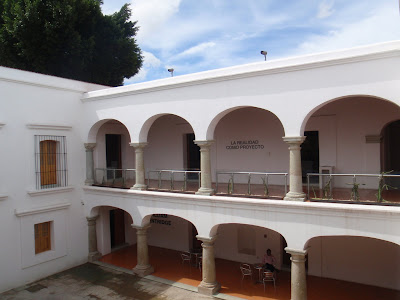
(Contemporary Art Museum)
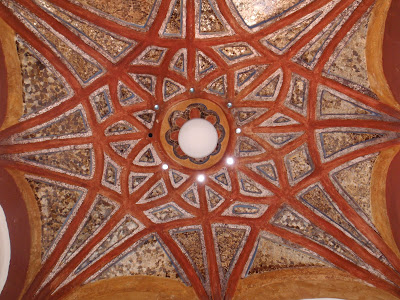
(ceiling of the museum)
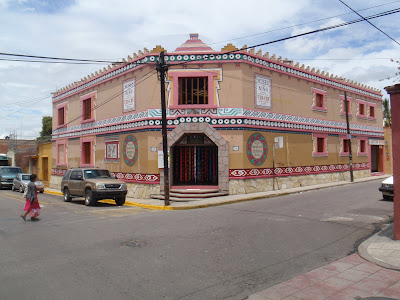
(Museum of Artifacts and Kids Museum)

(The Little Bull Meat Shop)
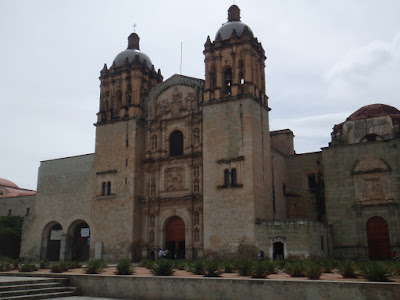
(cathedral)

(band playing in the rain)
One of our stops while touring was at a Mezcal shop. Mezcal is another Oaxacan specialty and is like tequila except arguably a little smoother, also made from agave. There are mezcal shops all over town and we lucked out in the one we went into because the lady let us sample about 20 different kinds. They make flavored creme that makes it taste a lot less mezcally, pleasant almost. Our favorite was mocha, so we bought some and took it back to the hostel. We offered the owner a shot and were scolded for bringing alcohol in because they serve alcohol there and it is stated clearly in the rules he had us read. Whoops.


(view from hostel roof)
For dinner, a restaurant caught Mike's eye because it had a sign that said "Bar 2 X 1." Jill wasn't as excited because the only person in the restaurant was an old man smoking a cigarette. Turns out the bar deal was only for one type of beer that was priced about double what it should be. The bar was also a karoake bar and a man already in the bar (previously out of view) sang several songs for us shortly after we came in. He was even kind enough to look for an English song to sing (Radiohead, in fact, truly English). The waiter and owner (the old man smoking a cigarette) were excited to have us there and gave us both a free shot of Mezcal and had us sign their guestbook. Although the food was pretty horrible, we had an interesting ending to the evening as Jill was hit on by the old owner and the karoake singer cried to Mike because his wife had left him that day, followed by long, elaborate wails of prayers after he sat back down at his table (also after a long and heated discussion with the bar owner as to how far he had made it through his purchased box of 10 beers).
We were going to leave the next day but decided to stay to see some sites just outside of town. We decided to go to El Tule, a tree that is approximately 120 feet in circumference. According to Wikipedia, it is the "stoutest" tree of any tree in the world. Mike really wanted to hug it, but it was fenced in so he only got to hug a branch. It was still much bigger than him. The area surrounding the tree is also very beautiful as the city has done a very good job with the gardens.

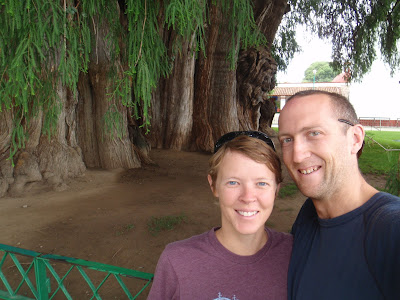


Next we drove on to the town of Mitla to see the ruins there. The Catholic church had again done a good job of building on top of indigenous structures, as this church even used some of the original stones as its foundation. The stones of the ruins were more detailed and ornate than we had seen at other sites, but it is pretty small. We were glad we snuck in the back way because the $3 fee to get in was maybe a little high considering you can see most everything from outside the structure. The site is surrounded by an artesanal market. Luckily, we had neither money nor room on the bike because there was some very nice stuff.
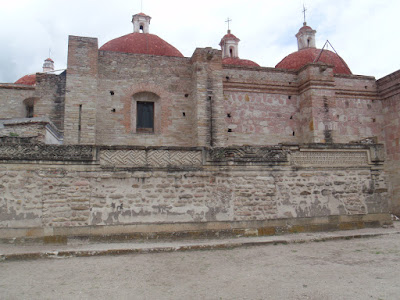

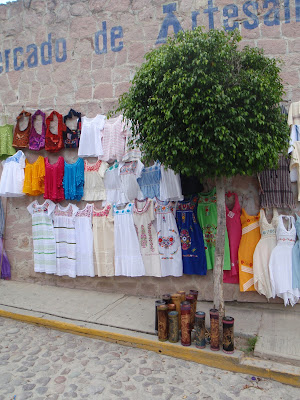
Just outside of Mitla heading back to Oaxaca we stopped in at a small scale Mezcal distillary and learned the surprisingly simple process.

(heat piña from the agave, or maguey, plant on hot stones covered with earth and tarp to hold in heat)

(crush the cooked piña by horse power)
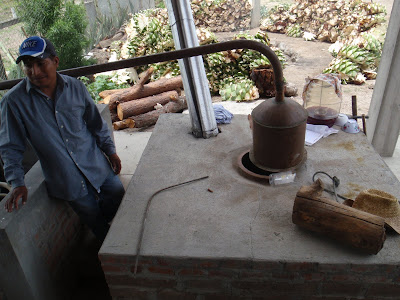
(copper distiller to boil the fermented product - fermentation tanks were wood barrels, where the cooked piña was stored in hot water for a few days)

(copper condenser)
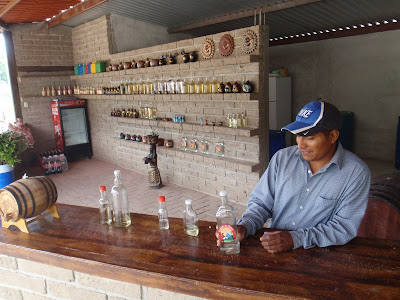
(drink - the raw product, reposado for 8 months, reposado for 2 years, or refinado (=double distilled and very smooth))

(drive - just kidding)
Then just outside of Oaxaca we detoured through the town of Teotitlan del Valle, known for its handmade rugs. Every other house was selling rugs and many had their own loom. Space constraints again were a good reason not to shop. The region is filled with artesanal towns specializing in various textiles, pottery, handicrafts and mezcal.
A friend Jill met in Tepoz was traveling through Oaxaca on her way to Costa Rica and she got to the hostel that evening. The next morning the three of us went to check out Monte Albán, ruins just outside of town. We took public transport and then hiked up the road to the ruins for another 2-3 kilometers. The ruins were older than many we have seen, as they were founded around 500 BC and continued to have importance as the Zapotec socio-political and economic center for about 1000 years. The ruins are huge and are spread over a hillside with views of surrounding cities all around. With probably 20 structures, it is by far the largest area of ruins we have seen yet (although people who have seen ruins further south and in Guatemala feel otherwise...).
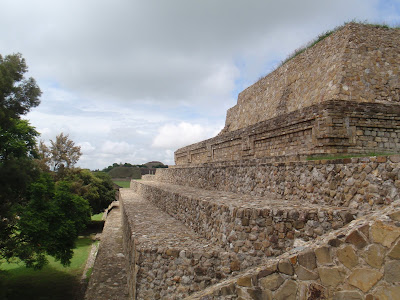
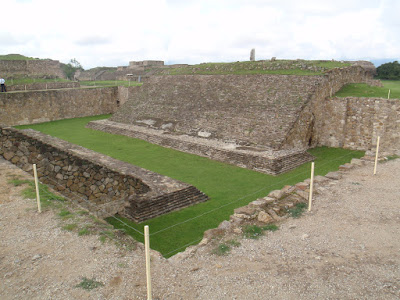
(ball field)




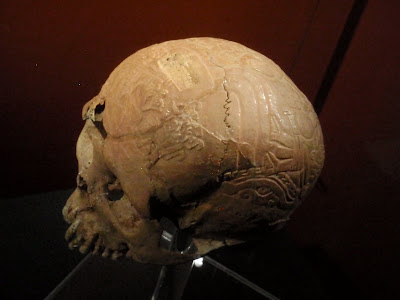
(intricate skull carvings on a skull showing early childhood deformation, common practices at Monte Albán)
Once back into town we had a wonderful meal in the market, including some of the mole negro that Oaxaca is known for - yum! spicy chocolate sauce on perfectly roasted chicken.


We got back to the hostel and a British group had purchased cooked crickets (chapulínes) and worms (guisanos, another Oaxacan specialty) so we got to try those without having to buy them. Mike had a cricket, which he describes as fried, salty, crunchy, crickety. Jill thinks she had the worm and she says it tasted like a raisin. Later, we got to talking with an American in the hostel who had seen a sign for artesinal beer, so we went to check it out. It ended up being a sweet bar that did sell microbrewed beer, including a Mexican Stout with chile. We were only able to afford one round of the good stuff, but have several more of the normal Mexican stuff before going back to the hostel and crashing a party being held by the owner of the hostel for his brother who was leaving Mexico for the states the next day. The night ended in us all going to get tlayudas at 3 am. We guess he forgave us for bringing our own drinks into the hostel from the day before because the beers he gave us were definitely not from the hostel.





